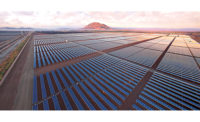The U.S. photovoltaic industry is expected to hit a milestone this year by surpassing the 1-GW mark, or generating enough electricity from the sun to power more than 200,000 homes. While California remains firmly in the lead as the nation’s largest solar power generator, the Northeast region is catching up and accounts for much of the milestone thanks to aggressive business and homeowner incentive programs, said speakers at the PV Power-Generation Mid-West & East conference, held in New York City on Nov. 8-9.
“The Northeast is the new California market,” Shaun Chapman, deputy director of government affairs at integrator Solar City, San Mateo, Calif., told attendees. New Jersey is by far the most active state in the region, as evidenced by its relatively new position as the country’s second-largest solar market. “If you are a serious [solar] project developer, you are doing something in New Jersey,” Chapman says.
As of the end of September, New Jersey had about 447 MW of installed solar capacity and 5,002 projects, totaling more than 569 MW, under way, says Mark Warner, founder and CEO of Sunfarm, Flemington, N.J., a solar installer. “There are about 345 installers, 275 of which [entered the market] in the last two years,” he says. Warner says that New Jersey is installing the equivalent of a small coal-fired powerplant in solar power each year.
The “volatile” N.J. market has undergone “explosive” growth during the last two years, in particular, Warner says. “A lot of people come in, do projects and disappear when they discover that it is a hard, [highly competitive] market,” he adds.
A big reason for New Jersey’s rise is its solar renewable-energy certificates (SREC) program, which requires electricity suppliers to secure part of their power needs from solar generators and allows developers to recoup some of their investment costs. The New Jersey market has become so saturated, however, that long-term SREC contract prices have plummeted. Several speakers at the conference see this as more of a market correction than a sign of its demise.
Rhode Island is another state growing its solar market share. A recently passed feed-in tariff program for solar and other renewable-energy technologies has annual targets for distributed generation, starting at 5 MW this year and up to 40 MW by Dec. 31, 2014. Connecticut recently passed LREC and ZREC programs for, respectively, low- and zero-emission energy credits that are similar to New Jersey’s SREC model.
Meanwhile, with PV panel prices falling, PVs are replacing concentrating solar power in some large-scale projects, says Sandra Burton, regulatory director at the non-profit Solar Electric Power Association. "The continued decline in pricing is leading to serious discussions of grid parity,” Burton says. The Northeast and Midwest are increasingly building utility-scale projects, she adds.
At the national level, the industry may get a boost from a recently launched Environmental Protection Agency and National Renewable Energy Laboratory joint study of 26 Superfund brownfield and former landfill and mining sites. The agencies are exploring the feasibility of developing biomass, geothermal, solar or wind energy production on the sites. The study, part of EPA’s "RE-Powering America’s Land" initiative, calls for EPA to provide about $1 million in technical assistance to the sites, says Lura Matthews, RE-Powering America’s Land project lead.




Post a comment to this article
Report Abusive Comment